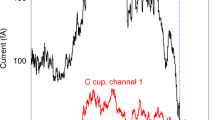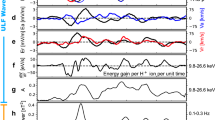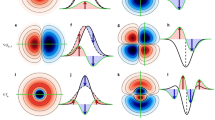Abstract
Most visible matter in the Universe exists as plasma. How this plasma is heated, and especially how the initial non-equilibrium plasma distributions relax to thermal equilibrium (as predicted by Maxwell–Boltzman statistics), is a fundamental question in studies of astrophysical1,2,3 and laboratory plasmas4,5. Astrophysical plasmas are often so tenuous that binary collisions2,3 can be ignored, and it is not clear how thermal equilibrium develops for these ‘collisionless’ plasmas. One example of a collisionless plasma is the Earth's plasma sheet6, where thermalized hot plasma with ion temperatures of about 5 × 107 K has been observed7. Here we report direct observations of a plasma distribution function during a solar eclipse, revealing cold ions in the Earth's plasma sheet in coexistence with thermalized hot ions. This cold component cannot be detected by plasma sensors on satellites that are positively charged in sunlight, but our observations in the Earth's shadow show that the density of the cold ions is comparable to that of hot ions. This high density is difficult to explain within existing theories8,9,10, as it requires a mechanism that permits half of the source plasma to remain cold upon entry into the hot turbulent plasma sheet.
This is a preview of subscription content, access via your institution
Access options
Subscribe to this journal
Receive 51 print issues and online access
$199.00 per year
only $3.90 per issue
Buy this article
- Purchase on Springer Link
- Instant access to full article PDF
Prices may be subject to local taxes which are calculated during checkout



Similar content being viewed by others
References
Priest, E. R. et al. Nature of the heating mechanism for the diffuse solar corona. Nature 393, 545–547 (1998)
Scudder, J. D. On the causes of temperature change in inhomogeneous low-density astrophysical plasmas. Astrophys. J. 398, 299–318 (1992)
Moses, R. W., Finn, J. M. & Ling, K. M. Plasma heating by collisionless magnetic reconnection: Analysis and computation. J. Geophys. Res. 98, 4013–4040 (1993)
Ono, Y., Inomoto, M., Okazaki, T. & Ueda, Y. Experimental investigation of three-component magnetic reconnection by use of merging spheromaks and tokamaks. Phys. Plasmas 4, 1953–1963 (2001)
Kodama, R. et al. Fast heating of ultrahigh-density plasma as a step towards laser fusion ignition. Nature 412, 798–802 (2001)
Hoshino, M., Mukai, T., Yamamoto, T. & Kokubun, S. Ion dynamics in magnetic reconnection: Comparison between numerical simulation and Geotail observations. J. Geophys. Res. 103, 4509–4530 (1998)
Baumjohann, W., Paschmann, G. & Cattell, C. A. Average plasma properties in the central plasma sheet. J. Geophys. Res. 94, 6597–6606 (1989)
Gary, S. P. Electromagnetic ion/ion instabilities and their consequences in space plasmas—A review. Space Sci. Rev. 56, 373–415 (1991)
Delcourt, D. C., Moore, T. E. & Chappell, C. R. Contribution of low-energy ionospheric protons to the plasma sheet. J. Geophys. Res. 99, 5681–5689 (1994)
Arzner, K. & Scholer, M. Kinetic structure of the post plasmoid plasma sheet during magnetotail reconnection. J. Geophys. Res. 106, 3827–3844 (2001)
Lakhina, G. S., Tsurutani, B. T., Kojima, H. & Matsumoto, H. “Broadband” plasma waves in the boundary layers. J. Geophys. Res. 105, 27791–27831 (2000)
Saito, Y. et al. Slow-mode shocks in the magnetotail. J. Geophys. Res. 100, 23567–23581 (1995)
Hirahara, M. et al. Acceleration and heating of cold ion-beams in the plasma sheet boundary layer observed with GEOTAIL. Geophys. Res. Lett. 21, 3003–3006 (1994)
Nishida, A., Mukai, T., Yamamoto, T., Kokubun, S. & Maezawa, K. A unified model of the magnetotail convection in geomagnetically quiet and active times. J. Geophys. Res. 103, 4409–4418 (1998)
Abe, T. et al. Observations of polar wind and thermal ion outflow by Akebono/SMS. J. Geomagn. Geoelectr. 48, 319–325 (1996)
Seki, K. et al. On atmospheric loss of oxygen ions from earth through magnetospheric processes. Science 291, 1939–1941 (2001)
Acknowledgements
We thank all GEOTAIL science members for their collaboration.
Author information
Authors and Affiliations
Corresponding author
Ethics declarations
Competing interests
The authors declare that they have no competing financial interests.
Rights and permissions
About this article
Cite this article
Seki, K., Hirahara, M., Hoshino, M. et al. Cold ions in the hot plasma sheet of Earth's magnetotail. Nature 422, 589–592 (2003). https://doi.org/10.1038/nature01502
Received:
Accepted:
Issue Date:
DOI: https://doi.org/10.1038/nature01502
This article is cited by
-
Near-Earth magnetotail reconnection powers space storms
Nature Physics (2020)
-
Shock waves in dusty plasma with two temperature superthermal ions
Astrophysics and Space Science (2017)
-
The Earth: Plasma Sources, Losses, and Transport Processes
Space Science Reviews (2015)
-
Non-adiabatic Ion Acceleration in the Earth Magnetotail and Its Various Manifestations in the Plasma Sheet Boundary Layer
Space Science Reviews (2011)
-
Earth’s ionospheric outflow dominated by hidden cold plasma
Nature Geoscience (2009)
Comments
By submitting a comment you agree to abide by our Terms and Community Guidelines. If you find something abusive or that does not comply with our terms or guidelines please flag it as inappropriate.



